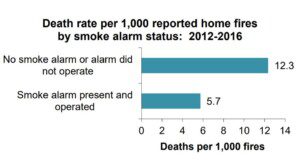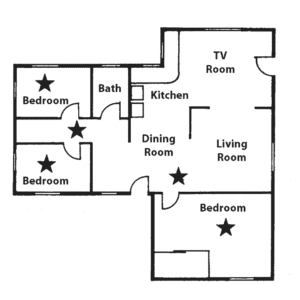Smoke Alarm Rules In Washington State:
Why We Need Alarms:
Smoke alarms are a key part of a fire escape plan and are vital for the protection of home occupants in case of a fire. Smoke alarms serve as an early warning system that gives occupants a chance to escape the home. In 2016 there were 1,800 fatal residential house fires in the United States. According to the National Fire Protection Association, 3 out of 5 fire deaths between 2012 and 2016 were in homes without smoke alarms or in homes where the alarms failed to activate. Home occupants are 54% less likely to die in a house fire when the home has smoke alarms that activate when there is a fire.
Washington’s Smoke Alarm History:
Washington building code has required smoke alarms in all dwellings since 1973. The requirements for locations and types of alarms have been updated since then to provide additional protection for the occupants of the home.
Minimum Smoke Alarm Requirements:
The minimum number of required smoke alarms in a home is defined by Washington Administrative Code 212-10:
-
At least one smoke detection device shall be installed to protect the sleeping area within each dwelling unit.
-
A sleeping area is defined as the area or areas of the dwelling unit in which the bedrooms (or sleeping rooms) are located. Where bedrooms or rooms ordinarily used for sleeping are separated by other-use areas (such as kitchens or living rooms but not bathrooms or closets), or are located on different stories or floor levels, they shall be considered as separate sleeping areas for the purposes of these rules.
-
-
Dwelling units with more than one sleeping area shall require the installation of additional smoke detection devices to protect each sleeping area.
The Administrative Code rules for smoke alarm locations are as follows:
-
Smoke detection devices shall be installed outside of bedrooms or rooms used for sleeping purposes but in the immediate vicinity of such rooms, centrally located in the corridor or area giving access to the rooms.
-
In dwelling units without separate sleeping rooms, the smoke detection devices shall be centrally located in the main room. Smoke detection devices shall be located on or near the ceiling.
-
A smoke detection device installed in a stairwell shall be so located as to assure that smoke rising in the stairwell cannot be prevented from reaching the detection device by an intervening door or obstruction.
-
Smoke detection devices in rooms with ceiling slopes greater than one-foot rise per eight feet horizontally shall be located at the high side of the room.
-
Smoke detection devices shall not be mounted in front of an air supply duct outlet or between the bedroom and the furnace cold air return.
-
Additional smoke alarm requirements go into effect based on the year the home was built or had a significant renovation. (See below for what constitutes a significant renovation.)
-
If the home was built or renovated after December 31, 1980, the alarms have to be hardwired. This means that they have to be connected to the electrical wiring of the home and have a battery as a backup.
-
If the home was built or renovated after July 1, 1992, smoke alarms are required in every bedroom.
Rules for New Construction Homes:
The following building code applies to new homes being built in Washington:
“Smoke alarms shall be installed in the following locations:
-
In each sleeping room.
-
Outside each separate sleeping area in the immediate vicinity of the bedrooms.
-
On each additional story of the dwelling, including basements and habitable attics but not including crawl spaces and uninhabitable attics. In dwellings or dwelling units with split levels and without an intervening door between the adjacent levels, a smoke alarm installed on the upper level shall suffice for the adjacent lower level provided that the lower level is less than one full story below the upper level.
-
Smoke alarms shall be installed not less than 3 feet (914 mm) horizontally from the door or opening of a bathroom that contains a bathtub or shower unless this would prevent the placement of a smoke alarm required by Section R314.3.
-
In napping areas in a family home child care.”
Rules for Renovated Homes:
Washington Building Code requires that any home that has had a significant renovation be updated to meet the same smoke alarm requirements as a new home built at that time. Meaning that a home renovated in 1996 has to meet 1996 smoke alarm building code requirements and a home renovated in 2018, has to meet 2018 code.
2015 Washington Residential Code R314.3:
“Where alterations, repairs or additions requiring a permit occur, or where one or more sleeping rooms are added or created in existing dwellings, the individual dwelling unit shall be equipped with smoke alarms as required for new dwellings.”
EXCEPTIONS: |
1. Work involving the exterior surfaces of dwellings, such as the replacement of roofing or siding, the addition or replacement of windows or doors, or the addition of a porch or deck are exempt from the requirements of this section. |
2. Installation, alteration or repairs of plumbing, electrical or mechanical systems are exempt from the requirements of this section. |



